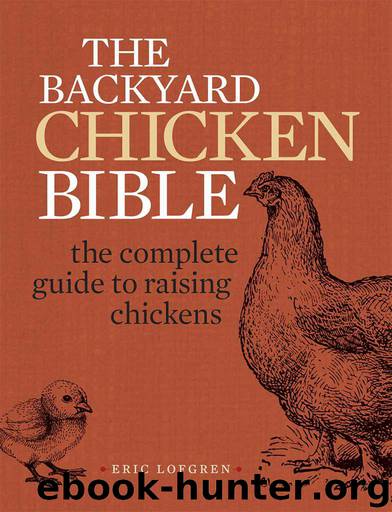The Backyard Chicken Bible: The Complete Guide to Raising Chickens by Lofgren Eric

Author:Lofgren, Eric [Lofgren, Eric]
Language: eng
Format: epub
Publisher: F+W Media
Published: 2014-11-13T22:00:00+00:00
4. MAINTAINING YOUR FLOCK
Hierarchy of Poultry Society
The Poultry Society is a dynamic hierarchical society—there is one lead rooster and one lead hen, followed in succession by the others. We generally refer to this as “the pecking order.” From just a few days old, chicks will begin establishing a pecking order within their group. This is who eats and drinks first and how they follow in line down to the weakest bird. As the chicks get older, they will begin sparring with each other to establish dominance. As they reach what we call the teenager stage, they can actually begin fighting amongst themselves, and as they reach the adult stage, if left on their own, it would not be uncommon for them to fight to the death.
Early on, during the chick stage, a young cockerel will display his dominance over the other chicks. As he and the others grow, this dominance will be challenged. If he wins this challenge, he remains the lead rooster; but if he fails, then another will take his place. The same holds true for the young pullets, but it is a much subtler approach. A lead rooster will control the flock. It is his duty to provide protection from predators by clucking and growling to warn the others of pending danger. It is also his duty to find food and water and to mate with the hens to perpetuate the flock. At any time, this lead role can be challenged and this includes by you. Chickens live in societal groups. Each chicken can recognize up to one hundred members of a flock. If you have more than one rooster, then each rooster will have control over his part of the flock. They will have their own territories, but these societal groups can overlap, and within a large flock the members of each sub-flock can change.
If you have an established flock and add another flock to it the new flock will stay to themselves and try to establish their own territory. If the new flock has a rooster in it, the established rooster and the new rooster will fight for control of territory.
It is very possible to have more than one rooster in a flock. Each rooster can easily take care of ten to twelve hens. If your poultry area is large enough and there are sufficient hens for each rooster, then they will form smaller subgroups and stay more to themselves, but you will still have one lead rooster over all the sub groups.
Have I confused you yet? Let me see if I can make this easier to understand by using our flock as an example. Right now we have approximately 150 chickens of various ages. We have six breeding pens, each with their own rooster. We also have a community pen that has two older roosters as well as one young cockerel. We let out one breeding pen of birds each day to mingle with the other community pen birds until we get to breeding season.
Download
This site does not store any files on its server. We only index and link to content provided by other sites. Please contact the content providers to delete copyright contents if any and email us, we'll remove relevant links or contents immediately.
| Automotive | Engineering |
| Transportation |
Whiskies Galore by Ian Buxton(41879)
Introduction to Aircraft Design (Cambridge Aerospace Series) by John P. Fielding(33064)
Small Unmanned Fixed-wing Aircraft Design by Andrew J. Keane Andras Sobester James P. Scanlan & András Sóbester & James P. Scanlan(32743)
Craft Beer for the Homebrewer by Michael Agnew(18140)
Turbulence by E. J. Noyes(7936)
The Complete Stick Figure Physics Tutorials by Allen Sarah(7307)
Kaplan MCAT General Chemistry Review by Kaplan(6866)
The Thirst by Nesbo Jo(6826)
Bad Blood by John Carreyrou(6552)
Modelling of Convective Heat and Mass Transfer in Rotating Flows by Igor V. Shevchuk(6391)
Learning SQL by Alan Beaulieu(6209)
Weapons of Math Destruction by Cathy O'Neil(6142)
Man-made Catastrophes and Risk Information Concealment by Dmitry Chernov & Didier Sornette(5921)
Digital Minimalism by Cal Newport;(5664)
Life 3.0: Being Human in the Age of Artificial Intelligence by Tegmark Max(5474)
iGen by Jean M. Twenge(5366)
Secrets of Antigravity Propulsion: Tesla, UFOs, and Classified Aerospace Technology by Ph.D. Paul A. Laviolette(5309)
Design of Trajectory Optimization Approach for Space Maneuver Vehicle Skip Entry Problems by Runqi Chai & Al Savvaris & Antonios Tsourdos & Senchun Chai(5011)
Pale Blue Dot by Carl Sagan(4912)
